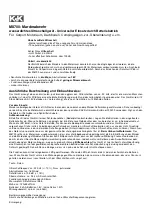
D-0134090-A – 2022/11
VisualEyes™ - Instructions for Use - EN
Page
13
Safety features and complaints handling
1.6.1
Complaints/safety reporting:
Please contact your local distributor in case of any incident related to product defects (hardware
defects or software bugs) or adverse events (which does not necessarily have a causal
association to the product). It is recommended for a user to report all the known facts about the
incident. Upon receipt of any serious incident with serious health impact for the patient or user
(serious adverse events), Interacoustics shall ensure that the regulatory authority in patient’s
home country is informed according to the vigilance requirements. Interacoustics shall handle all the product
complaints and adverse events as per the internal procedure.
1.6.2 Safety features of the product
The VisualEyes™ system provides various safety features to ensure patient safety and various error
messages as check points for the better performance of tests especially with all rotational chair options.
Refer to section 4.3 for details on the error messages. Other safety features are described below.
1.6.2.1 All types of rotational chairs
All types of rotational chairs (Orion Reclining/Auto Traverse/Comprehensive, System 2000 Reclining/Auto
Traverse/Comprehensive and Nydiag 200) have an
emergency stop button
which resides at the operator’s
station and the operator can manually override the system to stop the chair, laser, and optokinetic drum by
pressing the button. Rotating the emergency stop button will release the devices and the system is ready for
operation. The operator can restart the test from the software.
Rotational chair has seat belt to secure the patient from falling during the tests. Rotational chair tests do not
respond to the RF remote as an additional patient safety measure. Refer to Additional information guide for
more details.
1.6.2.2 Orion and System 2000 reclining chairs
The VisualEyes™ system does not allow a rotational chair to spin at the reclining position and the operator
immediately gets an alert message from the software.
1.6.2.3 Orion Auto-Traverse/Comprehensive chairs
The Orion Auto-Traverse/Comprehensive chairs come with a booth enclosure. The booth enclosure is wired
to ensure that the booth door is closed before testing. If the door is open, the test will not start. If you open
the door during testing, the test will be stopped, and the operator gets an alert message.
Note:
the chair, laser and drum are disabled for any test when the booth is open.
The patient-controlled stop button is secured on the right side of the head support of the Orion
Auto-Traverse/Comprehensive chairs. The patient can press the stop button during testing. Pressing the
button during a test will stop the chair, laser and optokinetic drum.
The chair has a built-in watchdog timer that checks if the software and chair are communicating. If there is no
communication, the watchdog timer will stop the chair, laser and optokinetic drum. Following, the operator
must exit the test or go to the home screen and restarting the test will reset the watchdog timer (refer to
section 4.3 to know more). If the fault repeats, the operator must address the issue before proceeding with
the test.
1.6.2.4 Nydiag 200 reclining chair
The patient-controlled stop button is located underneath the right armrest. Pressing the button during a test
will stop the chair.
















































